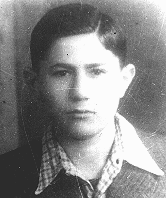|
Jakob was one of seven boys in a religious Jewish family. They lived in a town 50 miles west of Warsaw called Gabin, where Jakob's father worked as a cap maker. Gabin had one of Poland's oldest synagogues, built of wood in 1710. Like most of Gabin's Jews, Jakob's family lived close to the synagogue. The family of nine occupied a one-room apartment on the top floor of a three-story building.
1933-39: On September 1, 1939, just a few months before I turned 10, the Germans started a war with Poland. After they reached our town, they doused the synagogue and surrounding homes with gasoline and set them on fire. All the Jewish men were rounded up in the marketplace and held there while our synagogue and homes burned to the ground. Our house had also been doused with gasoline, but the fire didn't reach it.
|

